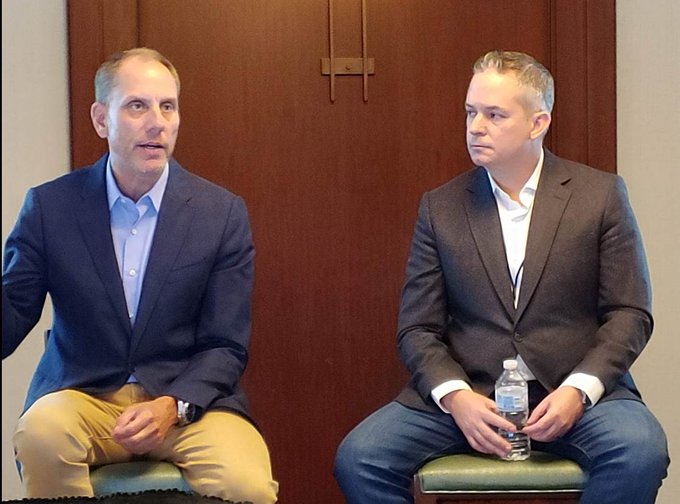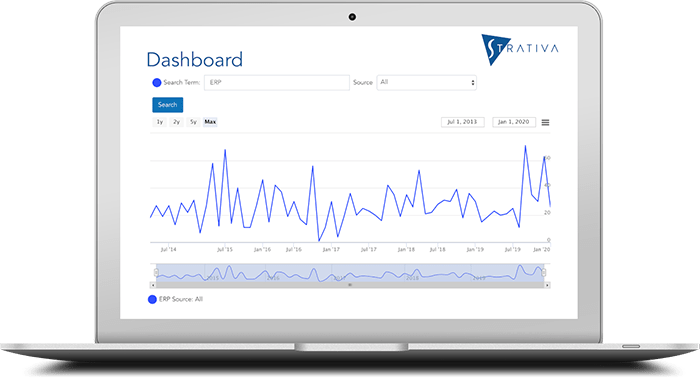
When does the relationship between two tech vendors look like a merger but is not actually a merger?
For all intents and purposes, that’s exactly what just happened with two players in the enterprise resource planning (ERP) industry. EQT Partners, a global private equity fund, recently finalized a deal to buy Acumatica. Although EQT already owns another ERP firm, Swedish-based Industrial and Financial Systems AB (IFS), it is not merging them. Rather, the two firms will work closely together, while remaining separate entities under the same EQT holding company. EQT’s Jonas Persson will serve as chairman of both companies, and IFS CEO Darren Roos (pictured above, on the right) will assume a seat on Acumatica’s board, according to the press release.
IFS may not have the name recognition of SAP, Oracle, or Microsoft, but at about 10,000 customers worldwide, IFS is much larger than Acumatica. It counts in its arsenal corporate giants such as Toyota, BMW, Pepsi, John Deere, and the largest container ship company in the world, Maersk.
It’s not that a merger was not on the table. EQT’s acquisition came after IFS considered buying Acumatica outright, Roos said recently at an analyst event. After carefully considering the situation, EQT decided that IFS and Acumatica are different enough that a different strategy was needed, to keep the two firms separate.
For its part, Seattle-based Acumatica has grown to more than 5,200 mostly small and midsize customers in 11 years. It is known for packaging its products into industry “editions.” Each edition marries Acumatica’s horizontal functionality (primarily financials, distribution, and customer management) with industry-specific modules, such as commerce, construction, manufacturing, field service, and distribution. Acumatica sells these editions through a network of value-added resellers (VARs).
‘Global Ambitions’
With the acquisition by EQT, Acumatica expects to significantly increase its workforce, CEO Jon Roskill (on the left in the photo) said at the analyst event. The company currently employs about 265 people worldwide. It will keep its brand and retain control over much of its operations, he added. But the acquisition will allow Acumatica to broaden its scope. “Our global ambitions are significantly larger than they were a year ago,” he said.
The fact that both IFS and Acumatica are now owned by EQT has prompted many questions. During the analyst day, Roskill said it was time to address the elephant in the room, “actually the two elephants,” (which drew a wry smile from Roos). The pachyderm is: Will the two compete for the same deals?
That won’t happen the vast majority of the time, several executives said. “There is really no overlap,” Roos said. “We don’t see each other in deals.” The two CEOs said they are currently figuring out what they can learn from each other and how they can share resources, developers, support, offices, and gain other synergies. (Speaking of developers, IFS recently opened a development center with 1,400 developers in Sri Lanka. Acumatica will also tap into that development force at some point.)
Geoff Ashley, Acumatica VP of partner strategy and programs, did due diligence on that competition question. With the acquisition pending, he and his enablement team contacted more than 50 percent of its VAR channel partners in North American and asked how often IFS faced off against Acumatica for a potential deal.
“We found one partner that had ever competed, ever, in the history of Acumatica and IFS, in North America,” Ashley said. There could be some situations where that might happen overseas, but it is still unlikely, he said.
No Overlap
Roos reiterated that point:
“Unlike some of our peers, where the overlap between the different solutions is pretty significant—in fact, there is so much overlap that you get very legitimate complaints from customers, namely, where does one solution fit and where does the other fit? That is just not the case with us. If anything, we probably need Acumatica to come up a bit more to get to where we want to stop, because I think there’s a couple of hundred million of unserviced revenue in the middle. We want to be in the half-a-billion-in-revenue-and-up space, and I’m keen to help Acumatica get to the point where they can go up to half a billion. And I think that’s a good segmentation for us to work on in the future.”
However, Roos said he can envision a possible two-tier ERP strategy in the future. “There’s a potential use case for a two-tier ERP. So, for instance, customers that would deploy IFS in the core, and then if they were looking for a subsidiary to start up something where they wanted the agility of a really quick deployment [they’d use Acumatica]. And that’s something that we are looking at. We’ve talked about it already, but there are loads of concrete things that Jon and I want to talk about.”
Roskill put the acquisition in these terms:
“[The acquisition] has given us a completely clean start. We got Acumatica to this point, and now it’s sort of a clean cut. And now we’re in the Acumatica next gen, whatever we want to call it. From my perspective, we’ve landed in a new place, with a supportive set of people around me, well-funded, and now we’re off to the races.”
IFS’s deep development team is something Roskill is keen to capitalize on. Acumatica has considered launching other industry editions, but it has not had enough developers to do it, he said.
After the acquisition was finalized, Acumatica launched a major software release, featuring a wide swath of improvements and additions, called 2019 R2. The updates revolve around ease of use, customization tools, best-of-breed functionality, and improved dashboards. Among the additions, Roskill said Acumatica has made it easier to migrate data from some older ERP systems, in particular data in Sage 100 and older Microsoft Dynamics systems.
Best to Let Buyers Decide
Despite the reassurances from the gathered executives at the analyst day near Boston, we believe there will be an increasing number of situations where both IFS and Acumatica could be short-listed for new deals, especially now that Acumatica is competing in the manufacturing and construction industries—two sectors where IFS is strong. In fact, Strativa is currently considering both solutions for some clients. It is our experience that it is not always obvious which solution will be the right fit. Hopefully, in the early stages of buyer interest, IFS and Acumatica will continue to offer their solutions to common prospects and let the prospect decide which system is the better fit.
The key to the success of the strategy going forward is whether the two companies can achieve the market segmentation goal. We have for years suggested that Acumatica has an opportunity to move up market. Today, the typical Acumatica customer is quite small, mostly in the under-100 employee range. Yet, the functionality that Acumatica already has is also relevant to larger companies, especially when their size comes from many small locations, as in local construction branches or small manufacturing plants. The mid-market up to the half-a-billion range could use more options, and we would like to see Acumatica move up into that neighborhood.
But the size segmentation will not always be a clear marker either. There are many aerospace manufacturers and government contractors under $500 million that will be far better served by IFS’s deep experience in these sectors, where Acumatica’s offerings are not as mature.
There is another potential reason that EQT Partners decided to keep Acumatica and IFS as separate entities rather than merge Acumatica into IFS. From the investor perspective, keeping the two as separate operational entities preserves greater flexibility and more options for the future. EQT can achieve most of the synergy and benefits of a merger while allowing a future sale of one while keeping the other, or selling the two as a package deal.
Overall, the move does appear good for buyers. We like the potential impact of this deal on accelerating Acumatica’s product road map. If Acumatica can efficiently tap into IFS’s development prowess and launch additional industry editions, it could be a huge boost to underserved segments. At the same time, if the more mature ERP vendor IFS can learn some new tricks from the cloud ERP upstart, then this could be good news for IFS customers as well. Finally, the pairing of IFS and Acumatica creates a more credible alternative to SAP, Oracle, Microsoft, and Infor, which is good news for the ERP market as a whole—a true win-win-win situation.
By Tom Dunlap, Research Director at our sister research firm, Computer Economics .
Photo credit: Jon Reed, Diginomica. Used by permission.

